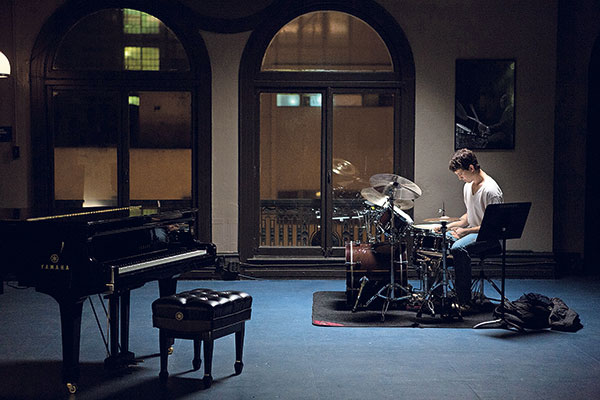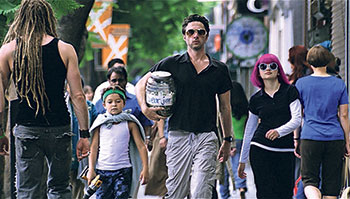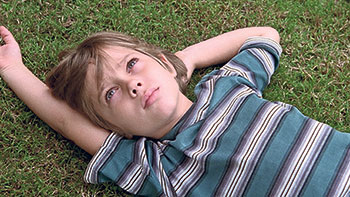Tales of youthful striving at Sundance

Roula Khalaf, Editor of the FT, selects her favourite stories in this weekly newsletter.
The 30th Sundance Film Festival started somewhat inauspiciously on the day that the nominations for this year’s Oscars were announced. Festival founder Robert Redford had widely been expected to receive a Best Actor nod for his role as a stranded mariner in All Is Lost , so there was an awkward atmosphere at the opening press conference when it was noted that his name was missing. Though Redford took the slight well, his reaction was revealing. “It’s a business,” he said. “In our case, I think we suffered from little to no distribution. And so, as a result, our distributors – I don’t know why – they didn’t want to spend the money [on an Oscar campaign].”
It was a trend reflected elsewhere in the festival. Although 2014 was a strong year for independent film in Park City, Utah, where Sundance is held, there was also a growing unease about the economic landscape. It used to be the case that smaller films such as All Is Lost would be picked up by major studios, receive limited, specialist distribution, and be promoted to score big at awards time. This year, however, there were fewer such deals and a lot more practical talk about the advantages of video on demand, which is where the lion’s share of this year’s entries are likely to be seen.

One of the standout films of the festival, Whiplash, also premiered that first day. The story of a talented jazz drummer (Miles Teller) and his sadistic mentor (JK Simmons), it was a superb curtain-raiser and yet it also stayed the course, taking home both the Grand Jury Prize and the Audience Award on closing night. Directed by 29-year-old Damien Chazelle, Whiplash is classic Sundance material, subverting the Hollywood underdog sports movie formula that suggests one only need to try to be the best. Chazelle’s film emphasises the pain that must be endured to achieve greatness.
Just behind it was Zach Braff’s Wish I Was Here, which the Scrubs star funded through the crowdsourcing website Kickstarter, saying he wanted to keep creative control. Some critics grumbled that the film might actually benefit from some studio interference. It is a step up from his debut, 2004’s Garden State, but addresses so many issues that it feels over-ambitious and crowded. Co-written with his brother Adam, it stars Braff as a struggling actor with a wife and two kids, who learns that his abrasive father (Mandy Patinkin) is dying of cancer. That in itself would be material enough for a movie, but Braff adds so many concurrent themes (being a father, a sibling, a son, a husband, Jewish, losing both parents) that it becomes a perfect storm of midlife crises – and Braff is only 38. Nevertheless, he has an easy charm and the comic scenes are touching and deadpan in Braff’s trademark wide-eyed style.
Also in the non-competitive Premieres strand was the darker and more complex Calvary. Directed by John Michael McDonagh, it is a powerhouse of a morality tale in which a noble priest in a remote Irish community receives a death threat from a parishioner. Though clearly inspired by the abuse scandals that have engulfed the Roman Catholic Church, McDonagh’s film is much more expansive than that, depicting a world where goodness is rare and love even rarer.

The runaway art house hit of the festival was Richard Linklater’s exquisite Boyhood, which stole some of the thunder from Lars Von Trier’s Nymphomaniac: Volume One (both parts of which have already screened in Europe). Filmed over a period of 12 years, Boyhood follows the life of suburban lad Mason (Ellar Coltrane) from the age of six to 18. Though there is no narrative to speak of, Linklater’s spellbinding film delivers a complete emotional arc via a series of vignettes that map out various points in Mason’s life. Coltrane is a real find, and the film rests comfortably on his young shoulders, but brilliant performances by Patricia Arquette and Ethan Hawke as the boy’s divorced parents are also central to this intimate epic.
Where Sundance used to thumb its nose at the nuclear family, this year’s line-up was the most conservative in a long time. A case in point is Lynn Shelton’s likeable Laggies, starring Keira Knightley as a directionless 20-something who makes friends with a teenager (Chloë Grace Moretz). The two actresses spark perfectly, but it’s hard to see Knightley’s privileged, aimless daddy’s girl striking much of a chord outside the US.
Laggies went down a storm with Sundance audiences, who are famously well disposed to films that are not so challenging. Two films, however, managed to buck that trend. The first was Michael Winterbottom’s The Trip to Italy, starring Steve Coogan and Rob Brydon, in which the two British comedians – both playing versions of themselves – travel to Italy to report on its restaurants. Although the two-hour film was cautiously edited down from a six-part BBC TV series to remove the more esoteric cultural references, Sundance audiences responded well to its meandering pace, despite extended scenes involving impressions of such British icons as hangdog comedian Frankie Howerd.
Standing ovations were afforded to Wish I Was Here (perhaps not surprising, since many in the audience had helped pay for it) and rock doc Lambert and Stamp, the frustratingly incomplete story of Kit Lambert and Chris Stamp, the managers who guided the Who to stardom in the mid-1960s. But the strangest film to lift Park City audiences to their feet was Gareth Huw Evans’s brutal, violent The Raid: Berandal (aka The Raid 2), which is likely to become one of the big releases from this festival. It may not do much business – the dialogue is in Indonesian and the blood flows freely – but Welshman Evans will now be on every major studio’s wishlist. Where The Raid (2011) was a low-budget actioner that took pride in its confined spaces – a high-rise tower block under attack by an anti-gang squad – Raid 2 is broad and masterly, putting the first film’s good cop Rama undercover in a simmering gang feud and climaxing in a car chase that beats Hollywood hands down.
This wild success was in sharp contrast to one of the most hotly anticipated films in the festival – Anton Corbijn’s A Most Wanted Man, based on John le Carré’s 2008 spy novel. Despite the best efforts of a terrific cast – Philip Seymour Hoffman, Willem Dafoe, Robin Wright – this story of a world-weary German secret agent (Hoffman) attempting to contain a suspected Islamic terrorist fizzles instead of catching fire.
Documentaries continued to be a key component of Sundance, but it soon became clear there would be no breakout. Stephanie Soechtig’s Fed Up came close, focusing on children with weight problems and promising to follow Morgan Spurlock’s Super-Size Me as an agenda-shaping critique of US eating habits. Like Spurlock’s film, it offers disturbing viewing, mostly in its investigations into sugar as a key ingredient of supposedly “low-fat” meals.
Major awards went to Syrian freedom fighter study Return to Homs and to Rich Hill, which looked at the lives of three boys in a poor part of Missouri. But for some, the documentary of the festival was Concerning Violence by Sweden’s Göran Hugo Olsson, a stark, visually blunt presentation of the writings of Martinique-born French writer Frantz Fanon. Using period footage and re-enactments, Olsson’s follow-up to The Black Power Mixtape is an incendiary piece of work, using the measured but perceptibly angry narration of singer Lauryn Hill to bring to life extracts from Fanon’s banned 1961 book The Wretched of the Earth, a searing indictment of colonialism that Olsson drives home with chilling scenes from the not-so-distant past in white-ruled countries such as Liberia and Zimbabwe.
But by far the most popular with audiences was Michael Rossato-Bennett’s Alive Inside: A Story of Music and Memory, which details a Florida careworker’s use of music to reach out to the residents of a nursing home. There’s little in the way of science, but the sight of elderly faces responding to music in a rapturous fashion reduced hardened festivalgoers to tears. Like many of this year’s films, it will struggle to find an audience in the wider world, but its Sundance success is a victory of sorts, a welcome reminder that at its best this is a festival about people and their stories, not just box office, Oscars or stars.
Comments